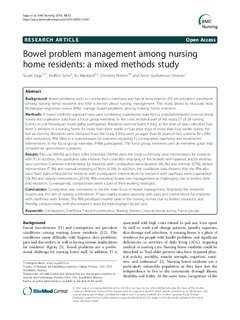| dc.contributor.author | Saga, Susan | |
| dc.contributor.author | Seim, Arnfinn | |
| dc.contributor.author | Mørkved, Siv | |
| dc.contributor.author | Norton, Christine | |
| dc.contributor.author | Vinsnes, Anne Guttormsen | |
| dc.date.accessioned | 2014-12-02T20:52:57Z | |
| dc.date.accessioned | 2016-05-02T13:26:56Z | |
| dc.date.available | 2014-12-02T20:52:57Z | |
| dc.date.available | 2016-05-02T13:26:56Z | |
| dc.date.issued | 2014 | |
| dc.identifier.citation | BMC Nursing 2014, 13(35) | nb_NO |
| dc.identifier.issn | 1472-6955 | |
| dc.identifier.uri | http://hdl.handle.net/11250/2388247 | |
| dc.description.abstract | Background: Bowel problems such as constipation, diarrhoea and faecal incontinence (FI) are prevalent conditions
among nursing home residents and little is known about nursing management. This study aimed to elucidate how
Norwegian registered nurses (RNs) manage bowel problems among nursing home residents.
Methods: A mixed methods approach was used combining quantitative data from a population-based cross-sectional
survey and qualitative data from a focus group interview. In the cross sectional part of the study 27 of 28 nursing
homes in one Norwegian municipality participated. Residents were included if they, at the time of data collection, had
been a resident in a nursing home for more than three weeks or had prior stays of more than four weeks during the
last six months. Residents were excluded from the study if they were younger than 65 years or had a stoma (N = 980
after exclusions). RNs filled in a questionnaire for residents regarding FI, constipation, diarrhoea, and treatments/
interventions. In the focus group interview, 8 RNs participated. The focus group interview used an interview guide that
included six open-ended questions.
Results: Pad use (88.9%) and fixed toilet schedules (38.6%) were the most commonly used interventions for residents
with FI. In addition, the qualitative data showed that controlled emptying of the bowels with laxatives and/or enemas
was common. Common interventions for residents with constipation were laxatives (66.2%) and enemas (47%), dietary
interventions (7.3%) and manual emptying of feces (6.3%). In addition, the qualitative data showed that the RNs also
used fixed toilet schedules for residents with constipation. Interventions for residents with diarrhoea were Loperamide
(18.3%) and dietary interventions (20.1%). RNs described bowel care management as challenging due to limited time
and resources. Consequently, compromises were a part of their working strategies.
Conclusions: Constipation was considered to be the main focus of bowel management. Emptying the residents’
bowels was the aim of nursing intervention. FI was mainly treated passively with pads and interventions for residents
with diarrhoea were limited. The RNs prioritized routine tasks in the nursing homes due to limited resources, and
thereby compromising with the resident’s need for individualized bowel care. | nb_NO |
| dc.language.iso | eng | nb_NO |
| dc.publisher | BioMed Central | nb_NO |
| dc.rights | Navngivelse 3.0 Norge | * |
| dc.rights.uri | http://creativecommons.org/licenses/by/3.0/no/ | * |
| dc.title | Bowel problem management among nursing home residents: a mixed methods study | nb_NO |
| dc.type | Journal article | nb_NO |
| dc.type | Peer reviewed | nb_NO |
| dc.date.updated | 2014-12-02T20:52:57Z | |
| dc.source.volume | 13 | nb_NO |
| dc.source.journal | BMC Nursing | nb_NO |
| dc.source.issue | 35 | nb_NO |
| dc.identifier.doi | 10.1186/s12912-014-0035-9 | |
| dc.identifier.cristin | 1177541 | |
| dc.description.localcode | © Saga et al.; licensee BioMed Central Ltd. 2014. This article is published under license to BioMed Central Ltd. This is an Open Access article distributed under the terms of the Creative Commons Attribution License (http://creativecommons.org/licenses/by/4.0), which permits unrestricted use, distribution, and reproduction in any medium, provided the original work is properly credited. The Creative Commons Public Domain Dedication waiver (http://creativecommons.org/publicdomain/zero/1.0/) applies to the data made available in this article, unless otherwise stated. | nb_NO |

